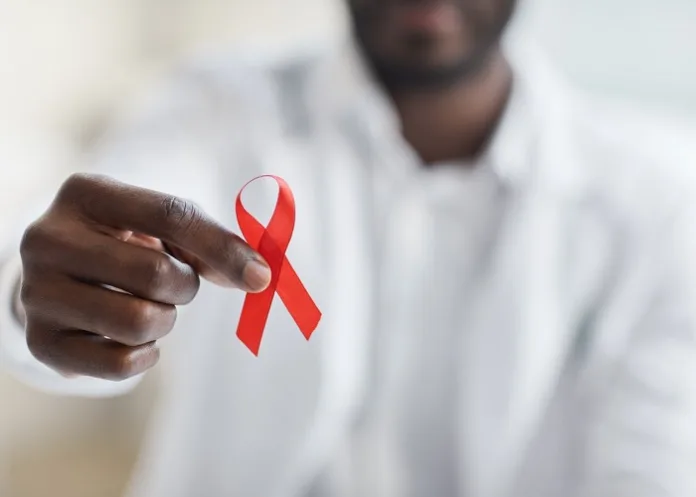The rate of new HIV infections in South Africa continues to fall, with statistics showing that in 2022, there were an estimated 164 000 new HIV infections, but these were three times higher back in 1999, when they peaked at around 538 000 in 1999.
Marcus Low writes in Spotlight that Thembisa, the leading mathematical model of HIV in South Africa, reports that 7.8m people, or 13.2% of the population, were living with HIV in 2022, and that infection was was much higher in certain sub-groups.
Some 31% of women aged 25 to 49 were infected, and among female sex workers, prevalence was estimated at 59%: for men 18 or older who have sex with men, the figure was estimated at 30%.
In general, prevalence was much lower in men than in women, and children had much lower prevalence than adults.
Deaths linked to HIV are also declining, with around 48 000 in 2022, less than a fifth of the peak of around 265 000 in 2005.
However, since the number of new HIV infections is much higher than the number of HIV-related deaths (164 000 vs 48 000), the absolute number of people living with HIV is still increasing.
Though at first glance this appears to be bad news, there is actually some good news behind it since the increase is partly driven by the fact that infected people are living longer.
Treatment coverage
Of the 7.8m people with HIV in 2022, around 5.7m were taking antiretroviral treatment and around 2.1m were not. This amounts to treatment coverage of 73.2% – or more than one out of every four people with HIV not being on treatment – constituting the biggest gap in South Africa’s HIV response.
On the UNAIDS 90-90-90 targets (recently reframed as 95-95-95), South Africa stood at 94.5-77.4-91.5 in 2022. Essentially, 94.5% of people with HIV were diagnosed, 77.4% of those diagnosed were on treatment, and 91.5% of those on treatment had viral suppression. (Note that the treatment coverage number in the previous paragraph is lower than the second 90 since the latter refers to only people diagnosed with HIV, while the prior includes all people living with HIV, whether or not they have been diagnosed.)
Recovery from Covid
The impact of the pandemic is evident in many of the Thembisa estimates. Life expectancy at birth, for example, dropped precipitously from 64.2 in 2019 to 58.5 in 2021 but then recovered to 63.5 in 2022. Despite the Covid-19-related disruption, the longer term trend of life expectancy having dropped due to HIV and then recovered due to the rollout of antiretroviral therapy, remains clear.
The number of people newly started on HIV treatment took a hit as Covid disrupted services in 2020. For every year from 2009 to 2019, more than 400 000 people were newly started on treatment – but In 2020, that number dropped to just under 260 000. It recovered to around 295 000 in 2021, but dropped back to 266 000 in 2022.
However, there was already a downward trend before Covid. In part, such a downward trend is to be expected since year-on-year it has been becoming harder to find people with HIV who are not yet on treatment, as they become fewer.
HIV prevention
Since most people with HIV who are stable on antiretroviral treatment become non-infectious, increasing treatment coverage is critical not only to their health but also to wider HIV prevention efforts. Getting the 73.2% treatment coverage level closer to 100% is thus an obvious priority.
But other forms of HIV prevention also play an important role. The Thembisa figures show that as of 2022, 62.5% of men and boys aged 15 to 49 in South Africa had been circumcised, equating to an increase of more than 20 percentage points over the past decade.
Medical male circumcision substantially reduces the risk of contracting HIV, and while the number of circumcisions performed was dramatically down in 2020, it has since recovered, though not quite to pre-pandemic levels.
Condoms also remain a highly effective means of HIV prevention, with condom use at last sex for women and girls aged 15 to 24 being relatively stable in the 35/36% range over recent years.
Finally, there has been an increase in the use of antiretrovirals to prevent HIV infection, although from a very low base. In 2022, only an estimated 0.8% of sexually active people were taking PrEP (up from 0.1% in 2018).
Among sexually active adolescent girls and young women, the number stood at 4% in 2022 – up from 0.1% in 2018. While these increases show progress, uptake would have to be much higher for it to start making a significant impact on infection rates.
See more from MedicalBrief archives:
HIV not over, warns UNAids South Africa director as infections spiral
When three epidemics collide: TB, HIV and COVID-19 in South Africa
TB clusters show where HIV treatment is missing in South Africa

